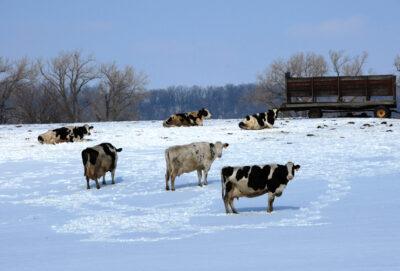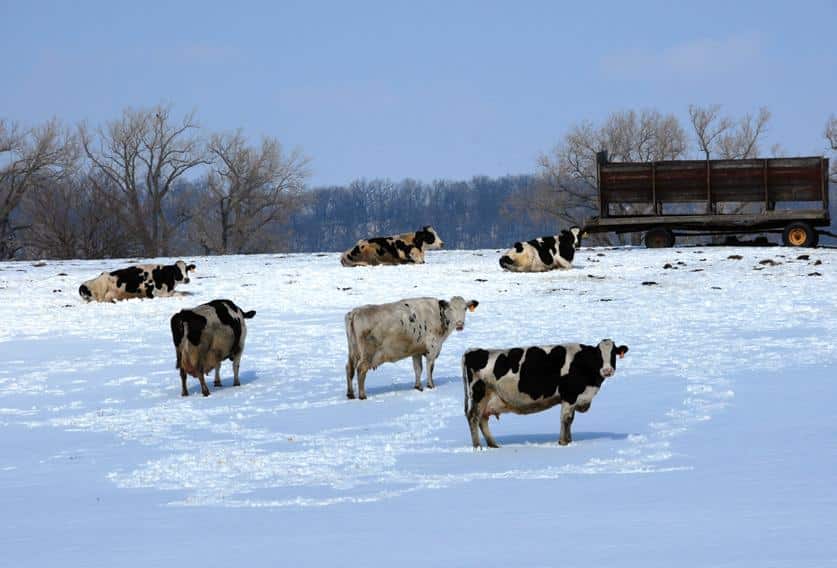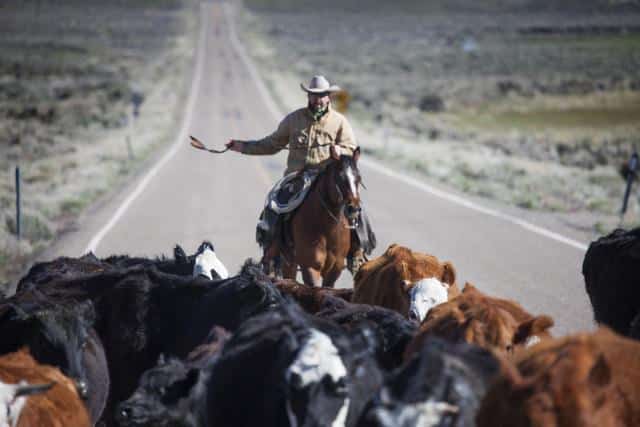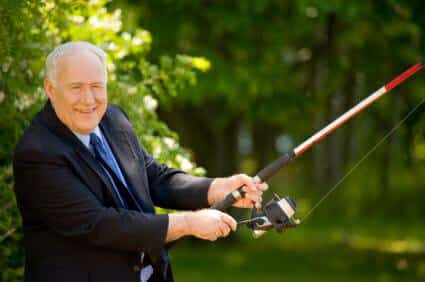
Dairy cows and other ruminants possess the marvelous ability to subsist off of grass, while producing nutritious milk and meat for humans. This ability to turn the inedible into edible has made cows valuable for centuries. Since cows can live off of grass, a cow on pasture can survive with little human intervention and many homesteaders raise healthy animals through intelligent grazing plans and supplementary minerals.
Cold winters can cause problems when trying to keep hungry dairy cows fed, however, especially if you do not have experience putting up feed yourself. If you are concerned about the upcoming winter months, then this article is designed to guide you through the process of preparing for winter.
1. Dairy cow dietary requirements
In order to stay healthy, a cow requires two main dietary components: roughage and protein. Both of these components can be met with a good quality grass during warm weather months, but high-producing dairy cows may require more protein, such as alfalfa, mixed grass-legume pasture, or a protein supplement. In addition to roughage and protein, cows will need salt and minerals, which can be easily supplied in a salt lick. During periods of growth or high stress, a small amount of grain can be fed for additional energy.
2. Winter nutritional requirements
In order to cope with colder temperatures, cattle grow thick winter coats and increase their production of body heat. They accomplish this by increasing their heart rate and respiration, thus increasing blood flow to keep extremities from freezing. Although this physiological response enables cows to withstand extremely low temperatures in relative comfort, they also require more feed in order to maintain their body weight.
A rough estimate for the amount of feed a cow requires is 2 pounds dry matter for every 100 pounds of body weight. Since cows may require up to 20 percent more feed during cold weather in order to maintain condition and ward off illness, the amount of feed you will need for your livestock may vary greatly. Since the amount of winter feed required will vary drastically from climate to climate and even from cow to cow, it is best to discuss winter feeding with neighboring farmers, veterinarians and extension agents, and then put up 10 percent more feed than you think you will need.
3. Feed options
Depending on your location, some winter grazing may be possible, but forages will likely be needed to supplement your animals. Although your feed options will be limited based upon availability, the following options will all make good feed.
- Hay
High-quality alfalfa hay can be used exclusively if you have access to this feed, but alfalfa is often much more expensive than grass or clover hay. Oat hay, wheat hay and pasture grass such as fescue hay are all good forage options, but they may be deficient in protein and/or phosphorous, so sending them to a nutritional lab for a nutrient profile is an excellent idea. Extension programs and dairy nutritionists will perform this service for a small fee.
Successfully Raise Farm Animals With The Backyard Homestead Guide…
Most homesteaders will need to purchase hay, but some will have access to their own land and equipment. If purchasing hay, it is a good idea to buy soon after it is put up. Hay is often cheaper in warmer months, and if you can inspect the hay early on, you can feel for heat. A bale that gives off a large amount of heat was baled too wet, and will be of significantly lower quality than well-dried hay. If you need to buy hay in winter, be sure to inspect for mold, rot, and weed presence, as all of these will negatively affect quality and should be reflected in the price.
- Silage
Although silage is not a common option among homesteaders, this storage method can be a good choice if you live in a wet climate where it is difficult to put up good hay. This method also works well if you cannot bale first-cutting grasses until they are too mature due to muddy fields. Wet hay leads to significant mold growth, rot and even hay fires. Silage allows for wet storage and yields high-quality feed that cows thoroughly enjoy.
Most homesteaders do not put up silage because historically silos were necessary to store the fermenting forage, an obviously high-cost option for a small operation. More current options include bunk silos (again, a poor option for homesteaders) or haylage. Haylage is made by baling forage wet and then wrapping the bale in plastic. This method produces high-quality, portable silage and can be a good winter feed, especially in milder, wetter climates.
- Grains
If you have experience with livestock or have read about dairy nutrition, then this section may seem elementary to you. However, I have seen much confusion and misinformation on this topic amongst my circle, and the misuse of grain has such serious consequences that they bear repeating.
Put simply, grain is equivalent to cake or sweet breads for humans—high energy foods with minimal nutritive value other than energy. Cows would consume grain naturally in the wild, but it would not be as energy-dense or as plentiful as it is in commercial crops. When grain is introduced rapidly and/or in high quantities, the pH of the rumen drops dangerously and acidosis occurs. Acidosis can cause a myriad of health problems or even death.
Due to this possibility, most homesteaders do not feed grain. On the whole, this option is the best for those who have unlimited access to high-quality forage, those who have low-producing animals; or those who live in mild to moderate climates. If you live in extremely cold regions, have a high-producing cow that tends to “milk the weight off,” or will be entering the winter with animals under 500 pounds, however, you may need to offer some grain in order to maintain animal health.
If you are forced to feed grain, be sure to introduce it slowly before the cold weather begins. Since cows may become lazy in the winter, be sure they are consuming a significant amount of forage every day, since the ratio of forage to grain is much more important than the amount of either. Lastly, feeding barley or wheat may be a better option than corn, since they are less energy-dense grains.
- Other
The adages “waste makes want” and “a penny saved is a penny earned” are dear to the heart of many who raise their own food, and feeding your dairy cow should be no exception. If you have a garden, you should salvage the potential cattle feed during the fall harvest to save on feed costs later in the year. Cucumber plants and skins left over from pickling, corn stalks, melon rinds and other garden waste can be shredded and sun-dried for forage. Most garden plants can be turned to suitable cattle feed. Beware of peppers, tomatoes and anything else in the nightshade family, however, as they may cause gastrointestinal discomfort.
4. Cow condition
The best way to prepare for winter is to improve cow condition before the cold weather hits. Since feed efficiency decreases in cold weather, it is much easier to put weight on a cow during the fall. Planning ahead by feeding extra forage (and possibly grain) will enable your cow to better withstand unexpected cold snaps and wind chill, and can save feed costs in the long run.
Winter feeding tips
- Although it may be more comfortable for you, indoor feeding usually is not advisable. Ammonia concentrations in poorly ventilated buildings can be exorbitantly high, causing pneumonia and other breathing problems; high humidity will decrease the insulating capabilities of a cow’s coat. Outdoor feeding will be perfectly comfortable for your cow, and often much cleaner.
- High-moisture rations will likely freeze in the feed bunks. If this occurs, intake will be reduced and more energy will be required to digest the feed. If you have issues with frozen feed, increase your number of feedings to three times per day.
- It is tempting to feed earlier and earlier as daylight decreases and evening temperatures drop, but your cow will be more comfortable if you delay feeding time in the cold. The activity involved in eating and the fermentation in the rumen will increase heat production during the evening.
- If you cannot afford high-quality hay, do not fret! Simply work out a dietary plan with your vet to make up for any nutritional short comings. Cows will consume high0quality hay with enthusiasm, but they are more likely to scatter low-quality hay. This scattering will reduce your bedding costs and will save you work. Although you will need more hay, you will need far less straw!










